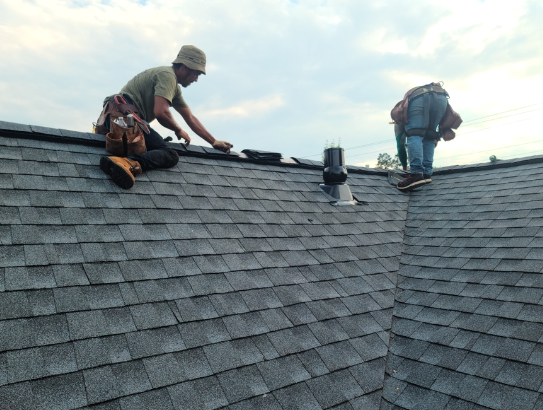Roofing is one of the most important structural elements of any building, especially homes. It serves a dual purpose: protecting the house from the elements and contributing to the aesthetic appeal of the property. While often taken for granted, the roof is a crucial component that requires careful consideration, regular maintenance, and eventual replacement. This piece will explore the significance of roofing, its various types, the importance of roofing maintenance, and the factors to consider when choosing the best roofing system for your home.
The Importance of Roofing
The roof is the first line of defense for a building against environmental conditions such as rain, wind, snow, and extreme temperatures. Without a solid roof, the structural integrity of a house can be compromised, leading to costly damages. In addition to its functionality, the roof also impacts the energy efficiency of the building, limiting its appeal and resale value.
Protection from Weather -Roofing shields the interior of a home from all types of weather. A high-quality, well-maintained roof ensures that no moisture seeps into the walls, ceilings, or foundations, preventing mold, mildew, and rot.
Energy-efficient characteristics are a common component of modern roofing materials. Some roofing types, like metal or cool roofs, can reflect sunlight and reduce heat absorption, lowering the cooling costs in hot climates. A properly insulated roof also helps retain heat in colder environments, cutting down on heating expenses.
Aesthetic Appeal- The roof plays a large role in determining the overall appearance of a house. Good roofing materials and designs can improve the architectural features of a building, making it more attractive and marketable.
Types of Roofing Materials
Roofing materials come in a wide variety, each with its own set of benefits, drawbacks, and costs. The type of roof you choose depends on your budget, safety, aesthetic preferences, and the architecture of your home.
1. Asphalt Shingles:
Because of their low cost and ease of installation, asphalt shingles are by far the most common roofing material in the United States. Asphalt shingles are available in many colors and patterns and provide excellent protection against rain and wind. Their lifespan is typically 15 to 30 years, depending on quality and installation.
2. Metal Roofing:
Metal roofs have become popular on homes and commercial buildings. They are known for their longevity, energy efficiency, and environmental friendliness because they can be made from recycled materials. Metal roofs are fire resistant and can last 50 years or more if properly maintained. They are also ideal for areas with high winds or storms because of their durability and resistance to extreme weather conditions.
3. Clay and Concrete Tiles:
Clay and concrete tiles are favored in regions with a hot climate, such as the southwestern United States.These tiles have excellent insulation, fire resistance and a service life of up to 100 years. Their distinct aesthetic, often seen in Mediterranean or Spanish-style homes, adds a unique and classic look to any property.
4. Slate:
Slate roofing is one of the most durable and long-lasting roofing options. A properly installed slate roof can last for over a century. While natural stone appears to enhance the beauty of any building, it is more expensive and requires special development due to its weight and weakness.
5. Wood Shingles and Shakes:
Shingles and shingles are usually made of cedar, redwood or pine. This roofing material has a beautiful, rustic look that complements certain types of architecture, such as a house or bungalow. However, they require more maintenance than other types of roofs and are less prone to fire unless treated with special fire extinguishers.
6. Flat Roofs and Rubber Membranes:
Flat roofs are common in commercial buildings, but they can also be used in modern residential architecture. These roofs typically use rubber membranes (EPDM), modified bitumen, or PVC for waterproofing. Flat roofs require proper drainage systems to prevent water pooling and potential leaks, but they can be cost-effective and are often used for rooftop gardens or outdoor living spaces.
Roofing Construction: A Comprehensive Guide to Building a Durable Roof
Roofing construction is a vital aspect of any building project, ensuring the structural integrity, weather resistance, and longevity of the roof. Whether it’s for a residential home or a commercial building, a well-constructed roof is essential for protecting the building from external elements like rain, wind, snow, and heat. Roofing construction involves multiple steps and components, including choosing the right materials, framing the structure, installing the underlayment, and applying the roof covering. This article will provide an in-depth look into the process of roofing construction, the materials used, and important considerations for building a durable and efficient roof.
Roofing Maintenance and Inspection
Like any part of a home, the roof requires regular maintenance to ensure it remains functional and aesthetically pleasing. Ignoring roof maintenance can lead to significant issues that may require expensive repairs or even a full roof replacement.
Regular Inspections:Homeowners should have their roofs inspected at least once a year, preferably before the rainy or snowy season. Regular inspections help catch minor issues, like loose shingles or small leaks, before they escalate into major problems.
CLEAN UP THE LEAVES:Especially in homes surrounded by trees, leaves, twigs, and other debris can accumulate on your roof. These items can trap moisture, causing mold or rot.
Gutter Maintenance: Clogged gutters can cause water to back up onto the roof, leading to leaks and water damage. Regular gutter cleaning ensures proper drainage and prevents roof problems.
Roof Repairs: Small repairs, such as replacing damaged shingles or sealing leaks, should be addressed promptly. Delaying these repairs can lead to more extensive damage, potentially affecting the underlying roof structure.
Choosing the Right Roofing System
When selecting a roofing system, several factors should be considered:
1.Climate:The local climate plays a significant role in determining the best roofing material. For instance, homes in areas with heavy rainfall or snow require materials with excellent water resistance, such as metal or asphalt shingles. In hot climates, materials like clay tiles or cool roofs are better at reflecting heat and keeping homes cool.
2. Budget:Roofing costs vary widely depending on the material, labor, and complexity of the installation. Asphalt shingles are generally the most affordable option, while slate and metal can be more expensive upfront but offer long-term savings due to their durability and energy efficiency.
3. Aesthetics:The roof should complement the architectural style of the home. For example, clay tiles look great on Mediterranean-style homes, while slate may be more suitable for traditional or colonial-style houses.
4. Durability:Homeowners should consider how long they plan to stay in their home when selecting a roofing material. If long-term durability is a priority, investing in metal or slate may be more cost-effective in the long run.
Conclusion
Roofing is an essential aspect of homeownership, protecting both the structure and the occupants from the elements. With a wide variety of roofing materials available, each with its own advantages and disadvantages, choosing the right one depends on a careful balance of budget, aesthetics, durability, and climate suitability. Regular maintenance and timely repairs are key to ensuring that the roof remains in good condition, safeguarding the home for many years to come.

